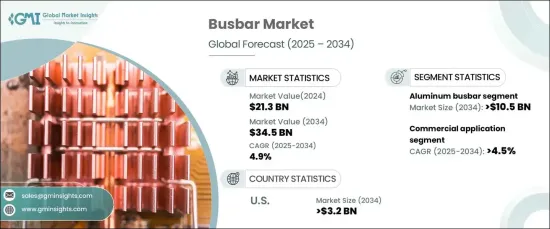
세계 부스바 시장은 2024년 213억 달러로 평가되었고, 2025-2034년 연평균 4.9%의 견조한 성장세를 보일 것으로 예상됩니다.
이러한 확장의 배경에는 주거, 상업, 산업 분야에서 효율적인 배전 솔루션에 대한 중요성이 강조되고 있기 때문입니다. 풍력 및 태양광과 같은 재생 가능 에너지원의 채택이 증가함에 따라, 부스바는 기존 배선 시스템에 비해 우수한 신뢰성, 컴팩트한 디자인, 에너지 손실 감소로 인해 선호되는 선택지로 부상하고 있습니다.

산업계가 지속가능성 목표를 달성하기 위해 에너지 효율적인 시스템으로 전환함에 따라 혁신적인 배전 기술에 대한 수요가 증가하고 있습니다. 또한, 스마트 시티 구상, 전기화 프로젝트, 건물에 대한 높은 수준의 자동화 통합은 특히 급속한 도시화를 경험하고 있는 신흥 경제권에서 시장을 촉진하고 있습니다. 모듈식 부스바 시스템 증가와 친환경적이고 재활용 가능한 재료에 중점을 둔 제조업체의 움직임은 부스바 산업의 환경을 크게 변화시키고 있습니다.
| 시장 범위 | |
|---|---|
| 시작 연도 | 2024년 |
| 예측 연도 | 2025-2034년 |
| 시작 금액 | 213억 달러 |
| 예상 금액 | 345억 달러 |
| CAGR | 4.9% |
알루미늄 부스바는 시장 성장에 있어 매우 중요한 역할을 할 것으로 예상되며, 2034년까지 105억 달러의 매출을 달성할 것으로 예상됩니다. 알루미늄은 경량 설계, 뛰어난 전기 전도성, 구리 대비 비용 효율성으로 인기를 끌고 있습니다. 이러한 특성으로 인해 전기자동차(EV), 항공우주 등 경량화와 작업 효율성이 중요한 산업에서 알루미늄 부스바가 선호되고 있습니다. 구리는 전도성과 내구성으로 인해 특정 응용 분야에서 우위를 유지하고 있지만, 새로운 기술에서 알루미늄의 우위는 그 중요성이 점점 더 커지고 있음을 강조합니다.
상업 분야는 2034년까지 4.5%의 연평균 복합 성장률(CAGR)로 상당한 성장이 예상됩니다. 도시의 급속한 확장과 상업 활동의 활성화로 인해 효율적이고 신뢰할 수 있는 배전 시스템의 필요성이 증가하고 있습니다. 상업 중심지와 도시가 계속 확장됨에 따라 에너지 절약을 지원하는 버스 바와 같은 소형, 고성능 솔루션에 대한 수요가 급증하고 있습니다. 사무실, 복합쇼핑몰, 비즈니스 센터는 지속가능성과 에너지 효율에 대한 관심이 높아지면서 에너지 낭비를 최소화하고 성능을 최적화하도록 설계된 첨단 부스바 시스템을 채택하고 있습니다.
미국의 부스바 시장은 첨단 에너지 효율 배전 시스템으로의 전환을 촉진하기 위한 국가적 노력에 힘입어 2034년까지 32억 달러 규모에 이를 것으로 예상됩니다. 이러한 노력은 송전 손실을 줄이고 국내 전력 네트워크의 전반적인 효율성을 향상시키는 것을 목표로 하고 있습니다. 부스바 설계 및 제조 분야의 기술 발전은 지속 가능한 인프라 개발에 기여하고 신뢰할 수 있는 에너지 솔루션에 대한 수요 증가에 대응하여 미국 시장을 세계 산업의 주요 기업로 자리매김하고 있습니다.
The Global Busbar Market, valued at USD 21.3 billion in 2024, is anticipated to grow at a robust compound annual growth rate (CAGR) of 4.9% between 2025 and 2034. This expansion is fueled by a growing emphasis on efficient power distribution solutions across residential, commercial, and industrial sectors. With the increasing adoption of renewable energy sources like wind and solar, busbars are emerging as a preferred choice due to their superior reliability, compact design, and reduced energy loss when compared to traditional wiring systems.

As industries pivot toward energy-efficient systems to meet sustainability goals, the demand for innovative power distribution technologies is on the rise. Furthermore, smart city initiatives, electrification projects, and the integration of advanced automation in buildings are driving the market forward, especially in emerging economies experiencing rapid urbanization. The growing trend of modular busbar systems and manufacturers' focus on eco-friendly, recyclable materials are reshaping the landscape of the busbar industry.
| Market Scope | |
|---|---|
| Start Year | 2024 |
| Forecast Year | 2025-2034 |
| Start Value | $21.3 Billion |
| Forecast Value | $34.5 Billion |
| CAGR | 4.9% |
Aluminum busbars are projected to play a pivotal role in market growth, with the segment expected to generate USD 10.5 billion by 2034. Aluminum is gaining traction for its lightweight design, exceptional conductivity, and cost-effectiveness compared to copper. These attributes make aluminum busbars a preferred choice in industries like electric vehicles (EVs) and aerospace, where weight reduction and operational efficiency are critical. Although copper continues to dominate specific applications due to its conductivity and durability, aluminum's advantages in emerging technologies underscore its growing significance.
The commercial sector is expected to experience substantial growth, with a CAGR of 4.5% through 2034. Rapid urban expansion and increasing commercial activities are intensifying the need for efficient and reliable power distribution systems. As commercial hubs and cities continue to expand, there is a surge in demand for compact, high-performance solutions like busbars that support energy conservation. Enhanced focus on sustainability and energy efficiency in office spaces, shopping complexes, and business centers is driving the adoption of advanced busbar systems designed to minimize energy wastage and optimize performance.
The United States busbar market is forecast to reach USD 3.2 billion by 2034, bolstered by national initiatives promoting the transition to advanced, energy-efficient power distribution systems. These efforts aim to reduce transmission losses and improve the overall efficiency of the country's power networks. Technological advancements in busbar design and manufacturing are contributing to sustainable infrastructure development and addressing the rising demand for reliable energy solutions, positioning the US market as a key player in the global industry.